Do you have little ones at home or in your classroom who are obsessed with all things dinosaurs? Are you also looking for ways to help your little ones learn to identify and articulate their feelings? Then today’s blog post is for you! I’m super excited to share with you my free dino-themed identifying emotions for kids worksheets.
In this blog post, we’ll explore the benefits of teaching emotions to your little ones, provide a detailed look at the worksheets included in this set, and share useful tips on how you can use them effectively in your classroom or in your home.
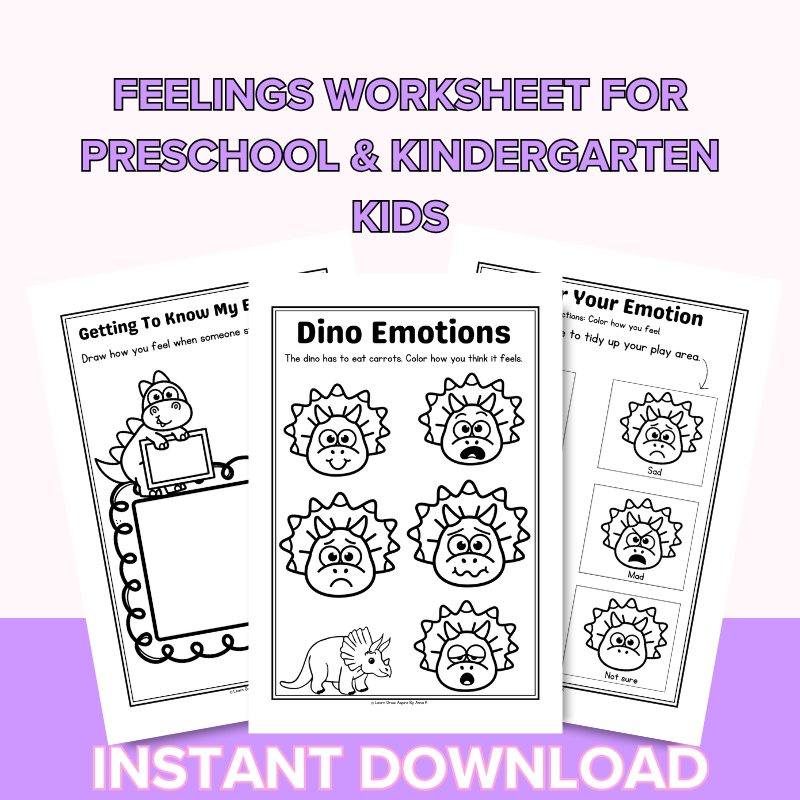
These worksheets are designed to make learning about emotions and feelings fun and approached for your preschool and/or kindergarten kids. Featuring adorable dinosaur faces and relatable scenarios.
SCROLL TO THE END TO DOWNLOAD YOUR FREE IDENTIFYING FEELINGS WORKSHEETS!
Understanding and expressing emotions is a critical part of early childhood development.
When children can easily identify and articulate their feelings, they will be able to foster empathy, build self-regulation, and positive social interactions.
What Are Emotion Worksheets?
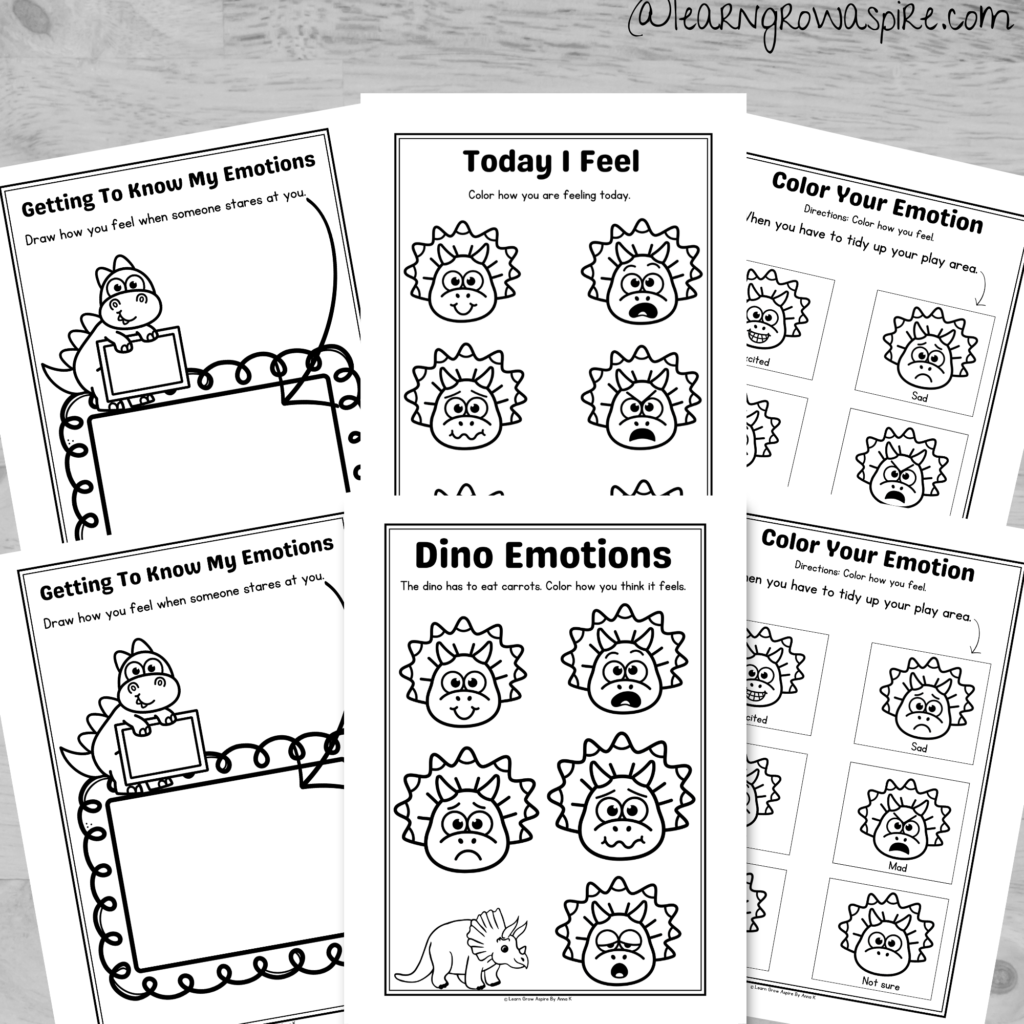
Emotion worksheets are designed to help children understand, recognize, and express their feelings with ease.
These worksheets typically include activities such as identifying facial expressions, matching emotions to scenarios, and practicing emotional vocabulary.
Emotions and feelings worksheets serve as a bridge to teach kids how to process their emotions in a healthy and constructive manner.
Emotion worksheets are particularly effective for:
- Teaching emotional literacy at home or in the classroom
- Encouraging self-expression.
- Building empathy by helping kids understand others’ feelings.
How Can You Describe Emotions to Kids?
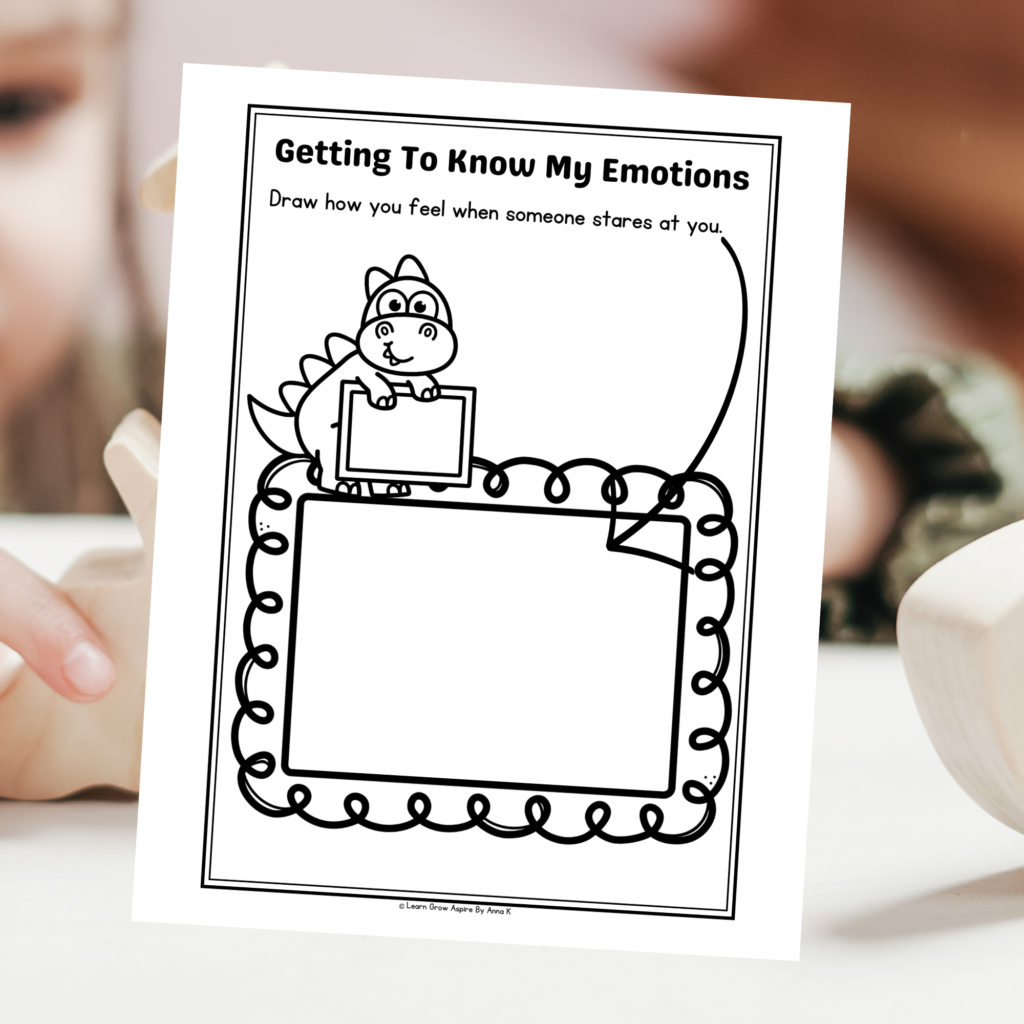
Emotions are feelings that we experience in response to different situations, people, or events. For preschoolers and kindergarteners, emotions can often feel overwhelming because they may not have the words to express what they’re feeling. (Heck it’s hard for us, adults, at times!)
Here are some ways you can consider using to describe emotions to your little ones:
Use simple and relatable language – You can say something along the lines of – “Being happy means you feel amazing inside, like when you’re playing with your favorite toy.”
Pair emotions with visuals – Show pictures of faces expressing different emotions and explain what each one means.
Use real-life examples – Relate emotions to situations they’ve experienced, such as feeling excited about a birthday or sad when a friend, grandma, or mom leaves.
At What Ages Can Kids Identify Emotions?
Children begin to recognize and respond to emotions as early as infancy.
Here’s a general timeline for you to consider:
0-1 Year – Babies can sense basic emotions like happiness, anger, and sadness through facial expressions and tone of voice.
1-3 Years – Toddlers start to label simple emotions like happy, sad, or angry. They may show frustration when they can’t express their feelings fully.
3-5 Years – Preschoolers expand their emotional vocabulary and begin understanding more complex emotions like fear, worry, or excitement. They also start to recognize emotions in others.
5-7 Years – School-aged children can identify a wider range of emotions and begin to understand that people can feel multiple emotions at once (e.g., nervous and excited).
Teaching emotions during the preschool and kindergarten years is particularly important because it sets the stage for emotional intelligence as they grow.
Why Teach Emotional Awareness to Kids?
As a parent or teacher, I’m sure you will agree that kids experience a wide range of emotions but often lack the vocabulary or tools to express how they feel. Especially when they are young.
Teaching emotional awareness will help your kids to:
Recognize feelings in themselves and others.
Develop self-regulation skills, reducing tantrums and outbursts.
Build empathy and strengthen social connections.
Lay the groundwork for healthy mental and emotional well-being.
Using visual aids and interactive activities is an effective way to help your children connect emotions with facial expressions and real-life situations—and that’s where our dino-themed worksheets come in!
Identifying Emotions For Kids Worksheets Included
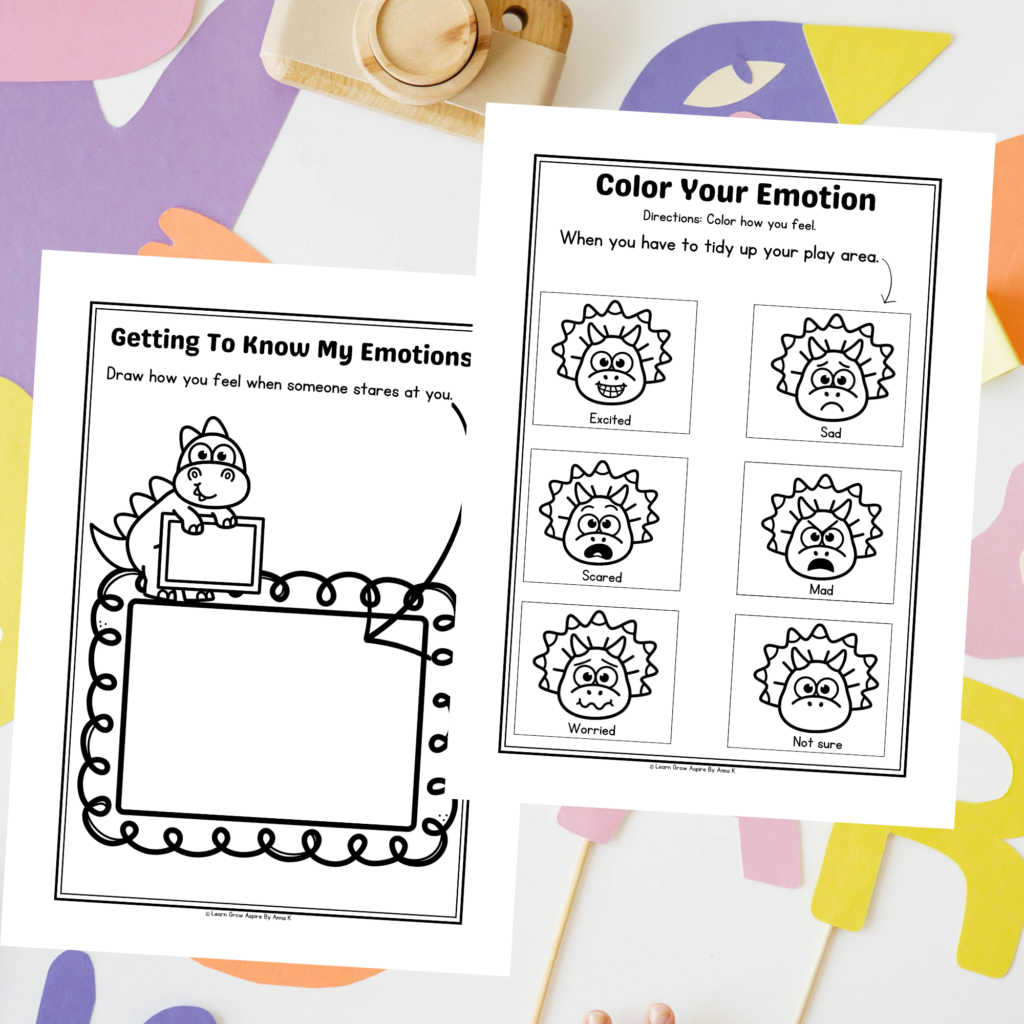
This set of free identifying emotions for kids worksheets is designed to be both educational and entertaining.
Here’s a sneak peek at what’s included:
1. Color Your Emotion Worksheets – In this worksheet kids are shown various dino emotions and are directed to color the emotion they are feeling today. This activity will help kids associate facial expressions with feelings and reinforce their understanding through a hands-on, creative approach.
2. Situation-Based Coloring Activities – These worksheets encourage kids to connect emotions with everyday scenarios. For example, they are directed to color how they feel when they have to tidy up their play area. And color how they think the dino feels when it has to eat carrots.
These relatable prompts help kids reflect on how they might feel in specific situations, promoting self-awareness and emotional recognition.
3. Draw the Emotion Worksheets – In this creative activity, children are encouraged to imagine and draw how they feel when someone stares at them. This open-ended task allows kids to express their thoughts and emotions through art, fostering creativity while reinforcing their understanding of emotions.
Tips For Using These Identifying Emotions Worksheets
Whether you’re a teacher, parent, or caregiver, these worksheets are super easy to integrate into your routine.
Here are some of my suggestions:
1. Classroom Circle Time – Use these identifying emotions worksheets for kids during morning circle time to discuss emotions with your entire class. Show the dino faces and ask children to describe the expressions before coloring how they feel.
2. Role-Playing Activities – Pair the worksheets with role-playing games where kids act out the emotions they see. For example, after coloring a sad dino face, ask kids to share what might make someone feel sad and how they can help a friend who feels this way.
3. One-on-One Conversations – Use the situation-based worksheets during one-on-one time to help children process their emotions. For instance, if a child recently experienced a challenging situation, you can guide them to reflect on how they felt and color accordingly.
4. At-Home Emotional Learning – As a parent, I have used these worksheets as part of our daily routine to check in with my children’s emotions. You can do the same. Sit together and talk about their day while completing a worksheet, helping them build a habit of emotional reflection.
Tips for Maximizing Emotional Learning
To get the most out of these worksheets, consider these tips:
1. Model Emotional Vocabulary – When introducing the worksheets, use clear and descriptive language to label emotions. For example, instead of just saying “angry,” you might say, “I see the dino’s eyebrows are down, and his mouth looks like he’s frowning. He looks angry or frustrated.”
2. Encourage Open Conversations – Ask open-ended questions as kids work on the activities. For instance, “Why do you think the dino feels worried in this picture?” or “Can you tell me about a time when you felt happy like this dino?”
3. Revisit Emotions Regularly – Please bear in mind that emotional learning isn’t a one-time activity. Revisit these worksheets or similar activities regularly to reinforce the concepts and ensure kids build a strong emotional vocabulary.
Benefits of Emotional Learning Worksheets
1. Engaging and Kid-Friendly Design – The dinosaur theme adds an element of fun and familiarity, making it easier for little kids to engage with the content. The cute and expressive dino faces are visually appealing and relatable.
2. Hands-On Learning – By coloring and drawing, your child or students will actively participate in the learning process. This hands-on approach enhances retention and makes abstract concepts like emotions more tangible.
3. Supports Social-Emotional Growth
These activities are designed to help little kids develop crucial skills such as recognizing their feelings, empathizing with others, and responding appropriately to different emotions.
Download Your Identifying Emotions Worksheets
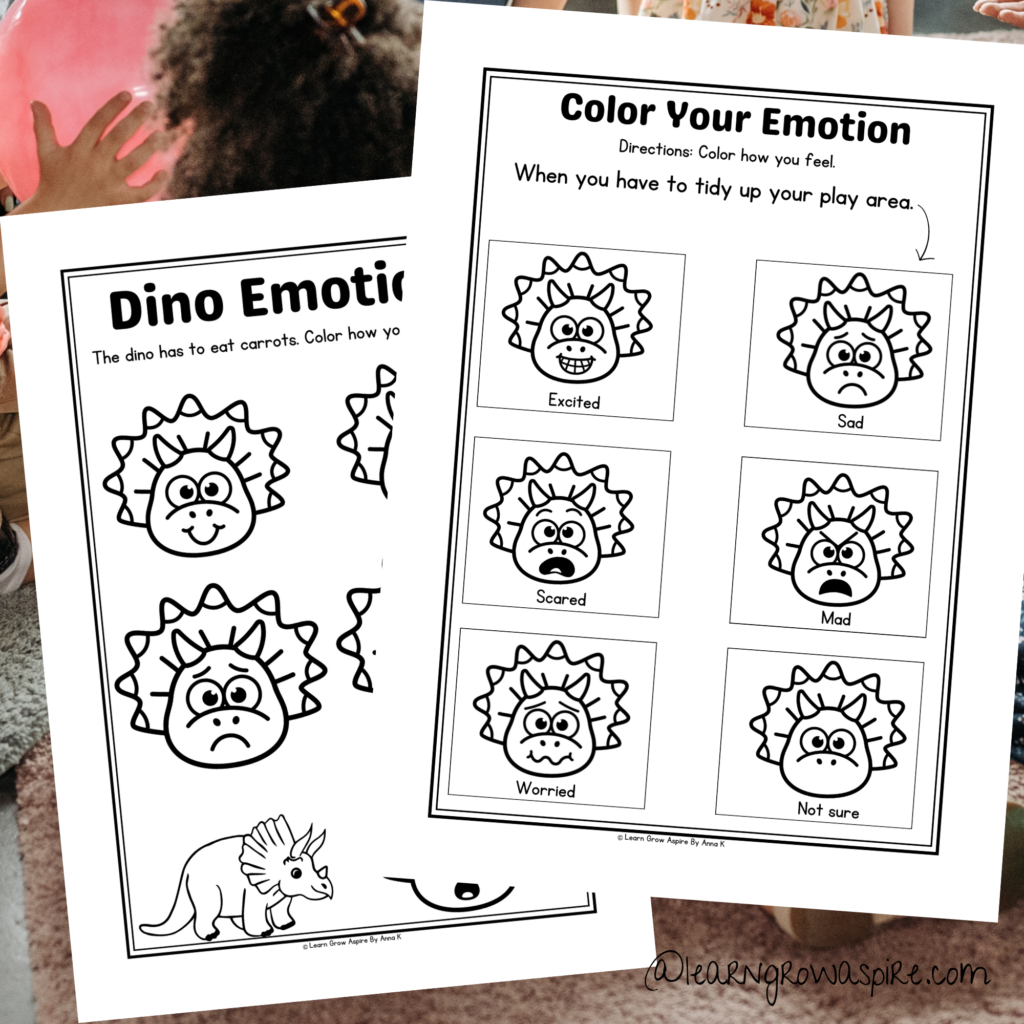
Go ahead and click on the link below to download your free dino-themed identifying emotions worksheets for kids.
These worksheets are perfect for preschool and kindergarten-aged children and can be used at home, in the classroom, or during therapy sessions.
Identifying Feelings Worksheets For Kids (586 downloads )
By equipping your kids and/or students with tools to understand and express their emotions, you’re setting them up for success both inside and outside the classroom.
Keep The Learning Going
If you and your kiddos loved these free identifying feelings worksheets and want more dino fun. Please consider taking a look at the full product line over on my Etsy storefront.
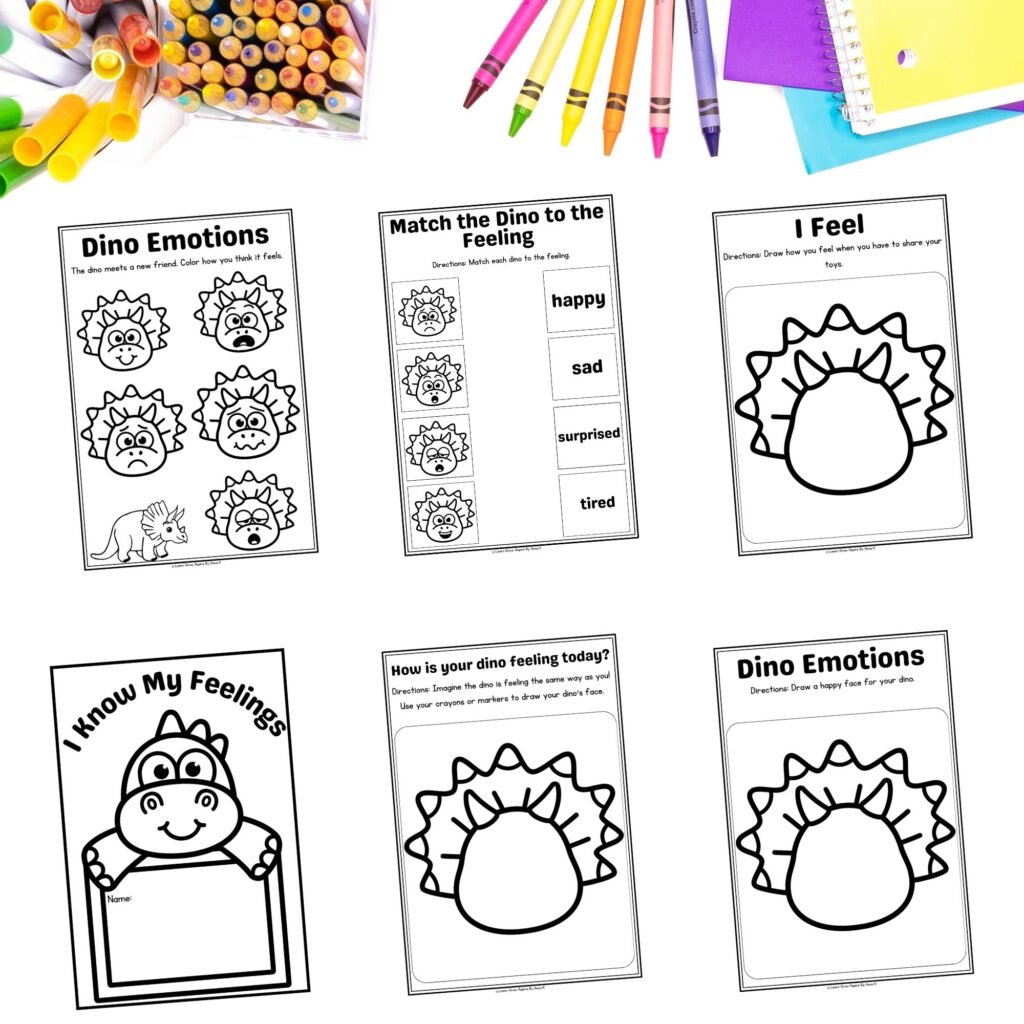
Related Blog Posts
You may also be interested in these blog posts:
- Free positive affirmation cards for kids
- How to give emotional support to your kids
- What to do when your kids are having big emotions
- 8 ways to validate your child’s emotions
Pin These Identifying Emotions Worksheets
Save these free Identifying Emotions For Kids Worksheets to your Pinterest board.
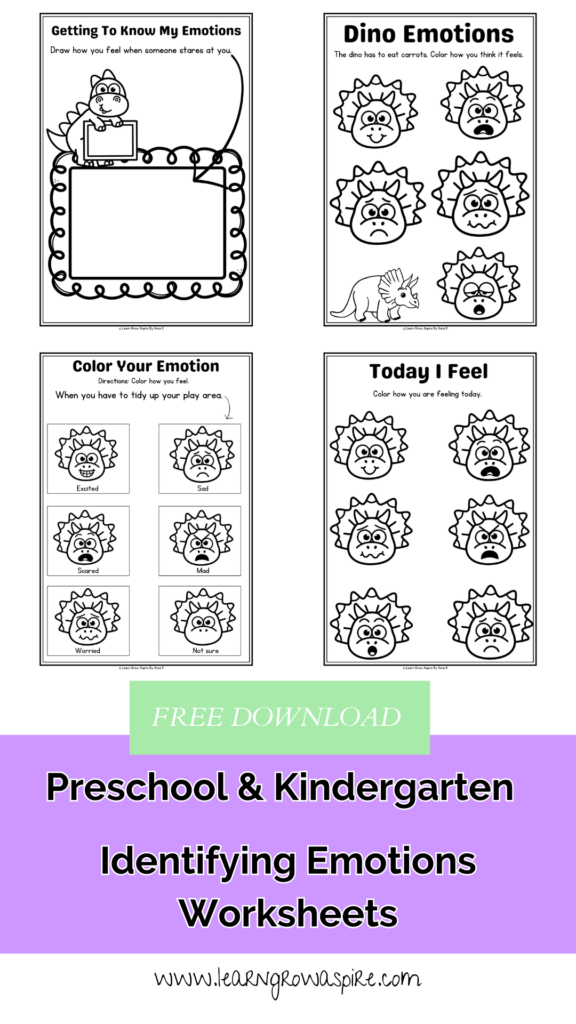
Some of the links in this post may be affiliate links. I’m also an Amazon Affiliate and will occasionally link to some of my favorite Amazon products. I will receive a small percentage back if you purchase through my link. You won’t be charged a penny more if you shop through my links. That said, I do NOT recommend anything I do not use and love! Thank you for helping support my blog!
